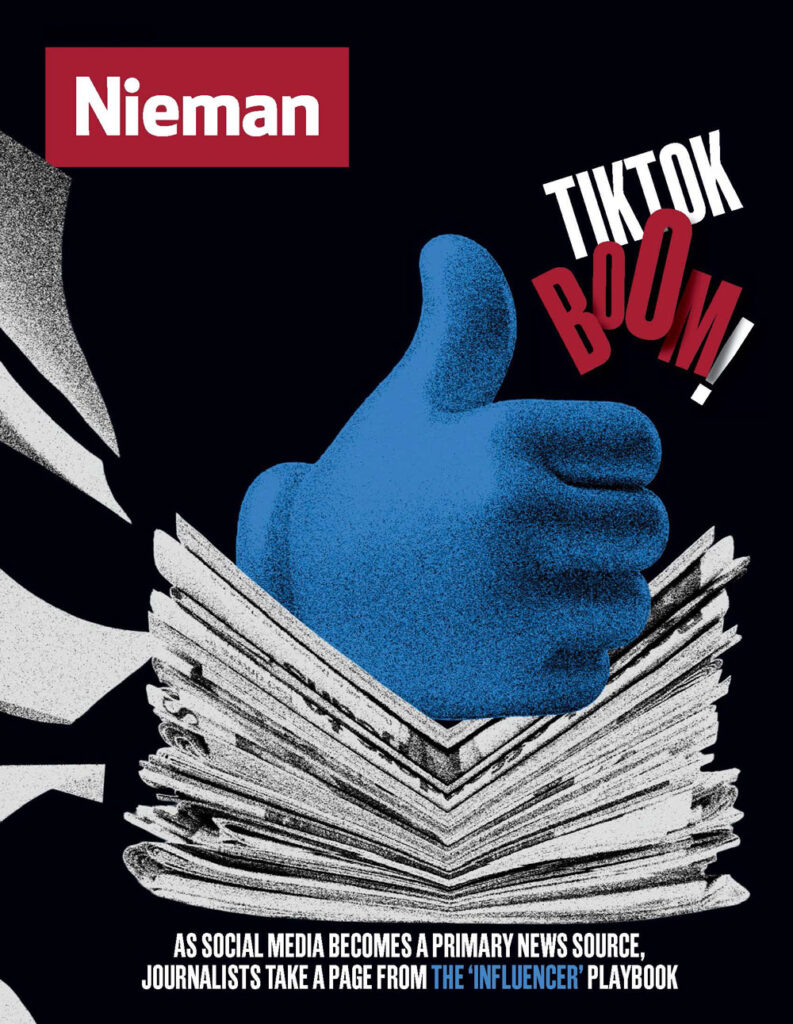It was 1977 and Mark Trahant had an idea.
He had already convinced the Sho-Ban News on his home reservation of Fort Hall in southeastern Idaho to spend $100 on an old Telex, a machine that could send short messages over telephone lines. The plan was to get other tribal newspapers to purchase them and create a network of Indigenous news with broader impact.
Trahant drove more than 1,000 miles round trip to and from south central Washington to pick it up. But the plan fell apart when his idea didn’t get any takers.
“That was one technological innovation that really flopped, but I learned a lot,” said Trahant. “You have to keep trying new things.”
Trahant, a member of the Shoshone-Bannock Tribes, has spent more than five decades in journalism pursuing innovation. In recognition of his expansive career, Trahant was awarded the I.F. Stone Medal for Journalistic Independence in April, administered by the Nieman Foundation for Journalism at Harvard.
Sporting his signature cufflinks, fountain pen and suspenders, Trahant has stayed true to his roots as he has sought to push boundaries and boost the number of Indigenous journalists and the reach of their work.
“The importance of Indigenous journalism grows as this country gets larger,” Trahant said when notified of his selection for the I.F. Stone Award. “It’s impossible to understand this country’s history — and its future — without including the people who have a 10,000-year history. So many of the problems we face today seem new, until you know how it fits into a longer arc.”
D. Parvaz, a 2009 Nieman Fellow, said that Trahant is someone who keeps family and his heritage at the forefront, is a master of difficult conversations, and is always casting an eye toward his next project.
“Mark, to me, is like water,” said Parvaz, whom Trahant hired onto the editorial board of the Seattle Post-Intelligencer. “You can try to block him, you’ll slow him down a bit, but he’ll create a damn canyon if he has to.”
“The importance of Indigenous journalism grows as this country gets larger,” Trahant said when notified of his selection for the I.F. Stone Award. “It’s impossible to understand this country’s history — and its future — without including the people who have a 10,000-year history."
Trahant faced one of those roadblocks early in his career as editor and publisher of the Navajo Times (later the Navajo Times Today). He had decided at the last minute to endorse Peterson Zah in the 1986 Navajo election for tribal chairman but didn’t tell the staff, he said. Zah supported a free press. But his opponent, Peter MacDonald, Sr., won, and then shortly after shut down the paper and fired its entire staff, citing mismanagement and poor finances.
Undeterred, Trahant moved on to a new venture with the Arizona Republic. He found himself back in the tribal capital of Window Rock in July 1989 as a riot broke out in protest of tribal lawmakers’ decision to remove MacDonald from office after he was accused of taking bribes and kickbacks, Trahant recalled. He and a photographer arrived by taxi and were surrounded by people carrying baseball bats and makeshift clubs. Two of MacDonald’s supporters were killed by police in the riot.
Amid the chaos, Trahant had a flash of clarity.
“This was that moment where you know how important journalism is,” he said. “I reached into my back pocket, and I pulled out my notebook, and everybody wanted to talk to me. …That power of being a neutral observer and coming into a contentious situation, and that notebook, how much power it had because people wanted their stories told.”
The Republic was Trahant’s first real job in mainstream media. He said it was a role he made his own by persuading editors to create a Western beat to cover water, resources and Native American tribes.
In 1988, Trahant was part of a team that uncovered widespread fraud, corruption, and mismanagement within federal agencies that serve Natives, including the U.S. Bureau of Indian Affairs. The series prompted a U.S. Senate committee investigation and was a finalist for the Pulitzer Prize for national reporting.
Nearly three decades later, in 2017, Trahant was at a Native American Journalists Association conference when Indian Country Today announced it would shut down. Trahant said he put out an open call to journalists to discuss the future of the publication, which not only sustained the livelihoods of Native journalists but had broad reach across Indian Country.
A month later, Trahant got a call from the National Congress of American Indians. It had acquired the paper by donation and asked if he would like to oversee a revival as editor. Under Trahant’s leadership, the staff of three increased tenfold and the outlet was rebranded as ICT as it sought to deepen and broaden its coverage with a newscast that now airs weekly and reaches viewers in the U.S., Canada, and Australia.
Ever the innovator, Trahant partnered ICT with First Nations Experience, a nonprofit television network dedicated to Indigenous content, to produce the first-ever live broadcast of a U.S. election focused on Indigenous candidates. Trahant had meticulously mapped them in a spreadsheet that he made publicly available ahead of the 2018 election.
After a crash course on scripts and an all-night writing session, the team was ready for an hours-long broadcast that could mark a historical first for Indian Country. Three women – Deb Haaland of Laguna Pueblo, Sharice Davids of the Ho-Chunk Nation, and Yvette Herrell of the Cherokee Nation – were all vying to become the first Native American woman elected to Congress.
What they didn’t anticipate was that Haaland, representing New Mexico, and Davids, representing Kansas, would both be declared winners early on, blowing up the script.
“We had to adapt the whole rest of the night,” Trahant said. “I remember right after, I was speaking in Minnesota in a little town and a young woman came up to me who gets FNX, and she said, ‘You know, this is the first time in my life that the news was for me.’”
In 2021, ICT moved under a new nonprofit that Trahant established as IndiJ Public Media – the type of organization he imagined while at Sho-Ban News and the Navajo Times Today. He served as editor-at-large and managing innovator until stepping down earlier this year.
He now chairs the nonprofit’s board as he works on book projects, one on Indigenous views of democracy, and the other on Native American female leaders in the 20th and 21st centuries that’s geared toward young readers.
“I remember right after, I was speaking in Minnesota in a little town and a young woman came up to me who gets FNX, and she said, ‘You know, this is the first time in my life that the news was for me.’”
— Mark Trahant, 2025 I.F. Stone Medal honoree
Holly Macarro, a citizen of the Red Lake Band of Ojibwe, who also serves on the IndiJ Public Media board, nominated Trahant for the position. She’s long admired his overall vision and the way he never lets details like funding get in the way.
He’s the journalist Indian Country relies on to explain issues like the Indigenous protests over the Dakota Access Pipeline, the history of tribal self-determination, and complicated cuts to Indian Health Service facilities, she said, because of his deep institutional knowledge, love of spreadsheets, and a writing style that makes it easy to understand.
But Trahant’s most lasting mark, she said, is uplifting young and Native journalists over decades.
“He’s always trying to center someone else or give someone else an opportunity,” she said. “It’s hardly ever about Mark Trahant.”
Felicia Fonseca, a 2017 Nieman Fellow, is the Mountain West Assistant News Director at The Associated Press.


